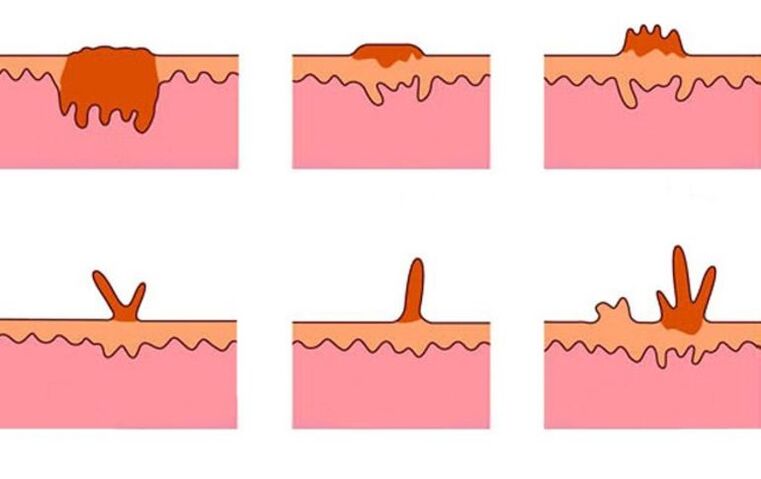
What is a papilloma?
Types of Papilloma
| Name | describe |
|---|---|
| simple | Compacted growth has a smooth, semicircular surface. They usually occur on the fingers, hands, and rarely on the knees. Similar formation occurs in childhood and adolescence. It usually goes away on its own without leaving any consequences. |
| flat | A formation with a circular shape. It's easy to notice them visually when they show their skin. They often trigger the onset of various inflammatory processes, and people complain of itching and burning sensations. Usually detected almost immediately after appearance |
| soles of feet | Papillomas, in the first stages of development, are often confused with calluses. After some time, it is possible to distinguish the edges of the structure and the center of the papilloma. People experience severe discomfort and sometimes pain when walking. Another name for this type of papilloma is thorn. |
| filamentous | An elongated growth that resembles multiple connected threads. Usually develops in older age. Most popular areas: neck, armpits, around eyes. Due to their awkward shape, they are characterized by a high risk of injury |
| genital warts | Papillomas are located on the mucosa. They are characterized by the highest degree of danger due to an increased risk of malignancy. These formations need to be eliminated urgently. If you notice this growth, you should consult your doctor immediately. |

causes of papilloma
among women

among men
Papillomas usually occur in the mouth, larynx, and trachea.
risk factors
- Immunity drops sharply and the entire body weakens.
- Continuous stress, nervous shock, chronic depression.
- Bad habits such as smoking and regular consumption of alcoholic beverages.
- Infectious diseases including ARVI, influenza.
- Gastrointestinal disorders.
- Have an active sexual life.
- Using certain medicines, especially antibiotics.
- Go to public places with high humidity: saunas, bathhouses, swimming pools, beaches.
location of papilloma
Danger
The area of the body where a papilloma was mistakenly removed is more likely to degenerate into a cancerous tumor.
- Genital warts located in the vagina degenerate. There is a risk of cervical cancer. This process lasts for a considerable time, but the disease itself does not show characteristic symptoms. Without preventive inspections, it is nearly impossible to detect violations. Pathology appears only in the final stages.
- If the papilloma is damaged, there is a chance that the infection will spread to undamaged areas. There is a risk of growths forming next to each other. If such interference is detected, increased viral activity needs to be noted and symptomatic treatment instituted.
- antiviral and immunomodulatory treatments;
- laser removal;
- Treatment of viral papillomas with nitrogen (cryodestruction);
- Radio wave therapy.
Papilloma Prevention
- Do not walk in public places with high temperatures and humidity without wearing shoes, as human papillomavirus may be present on the surface of floor coverings and plantar warts are highly contagious;
- You need to minimize physical contact with infected people and avoid using their personal belongings;
- During intimate contact, condoms should be used (unfortunately, this method does not provide a 100% guarantee, but it can significantly reduce the possibility of infection).























